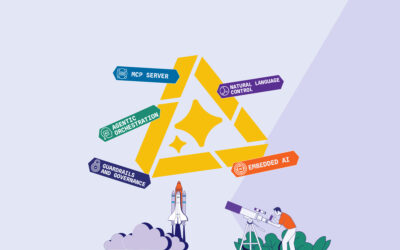In March, Steve O’Connor joined EIS as executive vice president of managed services. O’Connor, an IT business management veteran and former CIO of CSAA Insurance Group, a AAA insurer, will lead EIS’ managed services, overseeing EIS CloudCore, the SaaS delivery of our cloud-native application suite.
We caught up with Steve to discuss his experience as an EIS customer, why he joined the company, his vision for CloudCore and how his team will change the game for EIS customers. Steve also shared his thoughts on what the ideal insurance customer experience should look like, and EIS’ role in it.
You were an insurance customer of EIS for eight years. Introduce yourself, and tell us about your experience as a customer.
I’m originally from Boston, but spent several years in California in Silicon Valley. In 2011, I met [EIS CEO] Alec [Miloslavsky], and he and I formed a partnership. He was trying to build a great company and a great product that my company, AAA, needed. Over eight years, Alec and I met every month to help each other, and our enterprises, to be successful.
AAA is thriving today competitively and has transformed itself because of the applications EIS built and delivered to the marketplace. When I started at AAA, we had 1,800 people in IT, and the percentage of revenue being spent in IT was 11.5%. We had $2.6 billion in direct written premiums and 1.5 million policies in force. When I left eight years later, we had 650 people in IT, and went from 11.5% of revenue to 5.5% of revenue, went from $2.6 billion in direct written premium to $4.2 billion in direct written premium and 1.5 million policies in force to 2.1 million. We significantly grew the company and improved profitability at the same time. We transformed AAA’s insurance business and made the company significantly more competitive.
How are you and your team going to advance the production operations of EIS?
The marketplace recently said to EIS, we like your products and how you deploy them, and now we’d like you to help us operate them. Some call it SaaS, and we call it CloudCore. Eighty percent of system deployments end up in failure. You can have great technology, but if you don’t know how to deploy it, and operate it, you won’t be successful.
Alec brought me here because of my experience at AAA; he wants us to operate the platform as well or better than we did at AAA. Insurance companies are averse to change, and need to be more agile and flexible, like companies in Silicon Valley. You need to make that shift to be successful long-term in insurance.
Why did you join EIS, and what’s your vision for EIS CloudCore? How will your experience as an EIS customer carry over into your role at EIS?
I joined EIS for three reasons: first, I love Alec. He helped me immensely at AAA, and I wanted to help him continue to build a great company. Second, Mike Dwyer [EIS’ chief technology officer and executive vice president] and Rowshi Pejooh [EIS’ executive vice president, product] built a world-class product. It’s a world-class enterprise application that companies can grow and scale, and it’s unmatched in the marketplace. I wanted to be part of it because I used it for eight years, and I saw how fantastic it was. Third, I’m still a young man at 63, and I have a run in me to work with people I care about and a company where I value their purpose and mission. I have one good race left before I retire, and I wanted to do it with people I respect and admire.
Your philosophy is ‘know thy customer.’ What do you mean by this?
Insurance companies take decades to build their books of business, and small changes in the marketplace or systems can add huge benefits or cause significant harm. Insurance policies are promises: every policy is a promise that if something bad happens to you, I’m going to be there to help you recover your life. I take the promises my customers make to their customers very seriously.
At AAA, we sold auto and homeowners’ policies. We’ve had big earthquakes and fires in California, and half of AAA’s books of business were in California. If a AAA customer’s house or car burned, or their home was destroyed in an earthquake, we would be there to help them recover. I want all of us to understand our EIS customers, and who their customers are, and the promises they’re making. The system we’re building holds those promises. The EIS platform is the heartbeat of these insurance companies. The more we know about our customers’ customers, the better we can build that platform and make sure they’re successful. We’ll be successful if the insurance companies are successful.
How is insurtech catching up relative to other industries in terms of transforming itself and competing in the marketplace?
There’s a group of investors in the country, and around the world, who look at industries, where they can invest, to change business models and practices and disrupt entire industries. Over the last five to seven years, venture capital firms have been investing in insurtech firms to disrupt the insurance industry, like traditional investments that were made in technology companies 15 to 20 years ago. Some insurance companies have looked at this and said, ‘We don’t need to change.’ Others are saying, ‘We better get in the game and transform our business model, and become more tech savvy or these insurtech firms are going to kill our business.’
A third option is, insurance companies are creating their own venture capital arm and buying other companies that have created these technologies. EIS is at the heart of customer management, policy management, and claims management, and with DXP, we can help companies connect to that ecosystem easily. We’re at the foundation of what insurance companies and insurtech companies need. We have and will have sales cycles with all of these enterprises.
Tell us about EIS’ progress to date in SaaS. What role do our SaaS products play in our continued success?
Steve James [EIS’ executive vice president, global sales] and the sales organization recognized a year ago that SaaS would be a critical success factor in the marketplace – and today, we have nine contracts for SaaS customers. We’ve already sold nine SaaS customers in a year and half. That’s recurring revenue which is valuable to the company’s valuation. And a production operations function is being put into place to sustain and support these customers.
I’ve developed a five-year business plan for the SaaS business, forecasting 60 SaaS customers by the end of 2026. We have a production operations function to support and sustain current and future customers, and are hiring people to support those platforms for customers. I’m working with the sales team to improve sales materials and the pricing model to make it easier for our sales force to understand what we’re selling and sell it. Each piece has its own complexity, and anything we can do to simplify selling it is a good thing. We have a product data sheet that defines SaaS, CloudCore and what you get.
We’re working with marketing on how to improve messaging, and explain why someone would want to buy SaaS from us, why we’re different and better. I was a customer for eight years, so I knew people here before I joined EIS, and it’s about as welcoming a place as I could ever imagine.
When you put a new business in place, you have a solution; a business plan (we have it); sales, marketing and messaging (we’re working on it); and a team to deliver it. I’m focused on those four big buckets because that’s how we’re going to support our forecast of 60 customers by 2026.
How do partners help EIS in the marketplace?
In the marketplaces where we do business, there are well established partners that have relationships with customers that are more entrenched than the relationships we have today. If we can team up with partners who have those relationships with potential EIS customers, then we can grow our company faster than if we did this alone.
At EIS, we get paid because of speed. How can we help our customers achieve their objectives faster than anyone else in the marketplace? We know how to help our customers go faster and our company will deliver what they want better, faster, more securely, and less expensively than our competitors. This will give our customers a competitive advantage. If we can do that, working with partners, it’s worth millions of dollars to those partners, who have experience helping customers deploy enterprise applications. So, if I wanted to grow my services business, I could try hiring more people, but if I want to scale it and grow it faster, having partners with that experience is a multiplying effect in our ability to create many more successful customers faster. Also, in the SaaS business, our partners are critical for us in operating these systems, especially AWS and Azure.
What’s your vision for EIS as an organization?
At AAA, when I started, I had 400 vendors that I was buying for every year. My philosophy was, have the minimum number of vendors to deliver what you need. Fewer is better – I get more attention and more purchasing power. When I left, we had 100 vendors and we were spending more on those 100 vendors: Oracle, Sisco, AT&T. The vendor I spent the most with was EIS, and it’s the one vendor I didn’t have a vendor relationship with. I had a partnership.
The vision I have for EIS is that every customer thinks about us the way I thought about EIS when I was a customer. Alec was really interested in my business and what I was trying to do. He felt like, if he could serve me, the money and revenue would flow to him, and it did. I kept giving him more money because I believed in him, his company and his technology and product. I tell customers now that I want them to have the same relationship with us that I have with EIS. It’s more than being a supplier; it’s being there for our customers when they need us most. If we do that, our customers will be successful and the revenues will multiply for EIS.
You’re a big sports fan, and just like insurance, there are many different types of sports. Who do you like to cheer for?
I grew up in Boston, and even though I left Massachusetts 30 years ago, I still read The Boston Globe every day. I follow the Patriots, Bruins, Celtics, and Red Sox. I live in Florida and I still have a bromance with Tom Brady.
Find out more about EIS. Book a call.




